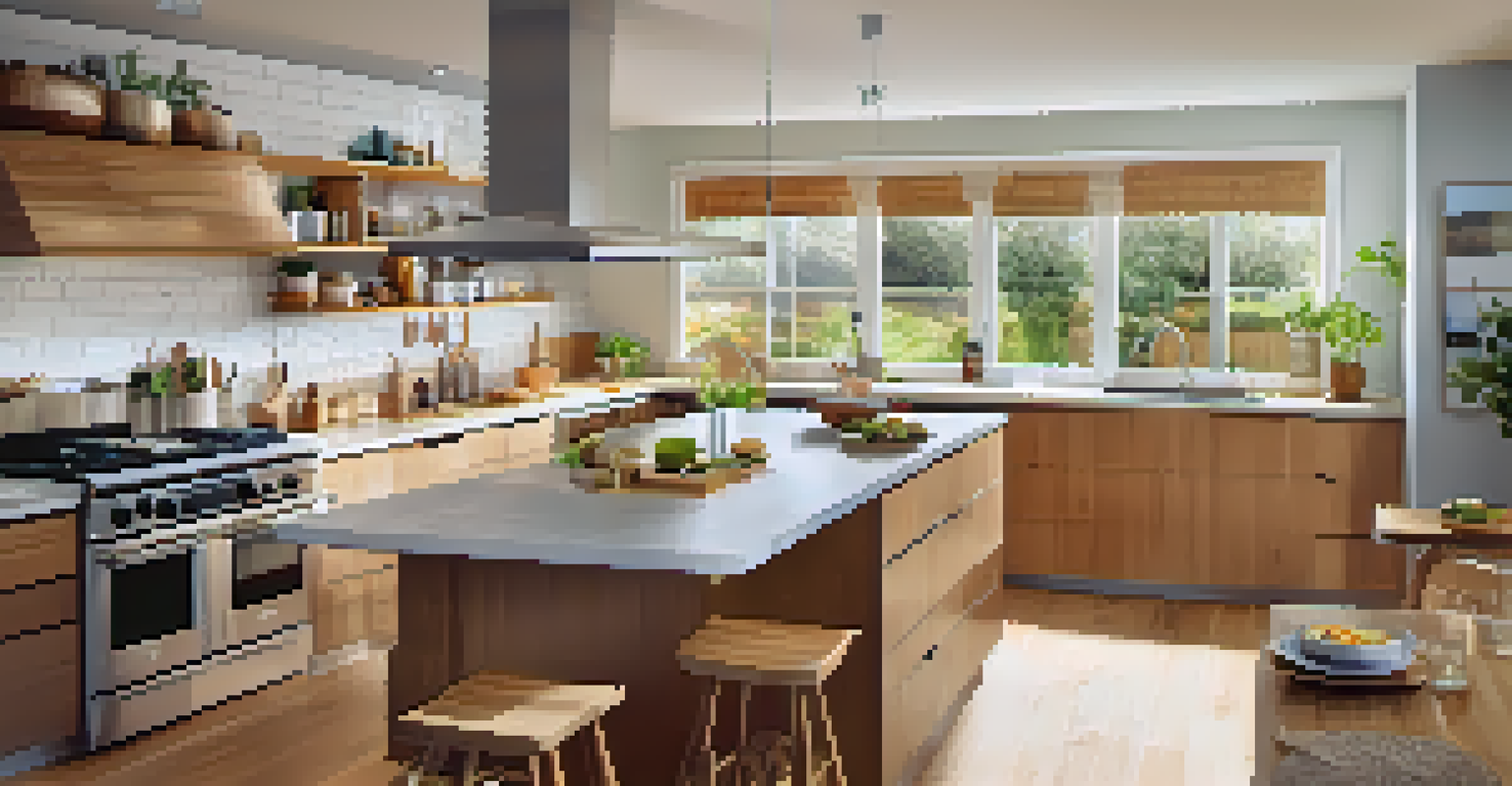Creating Multi-Generational Eco-Friendly Homes

Understanding Multi-Generational Living Benefits
Multi-generational living is becoming increasingly popular, especially as families seek to strengthen bonds while sharing resources. This arrangement allows different generations to support each other—whether it's childcare, companionship, or financial assistance. Plus, it can save on living costs and reduce the environmental footprint by sharing a single home.
The family is one of nature's masterpieces.
Imagine a household where grandparents share stories and wisdom with grandchildren while parents manage the day-to-day hustle. This vibrant atmosphere fosters stronger relationships and creates a rich tapestry of family culture. It's not just about living together; it's about building a supportive community under one roof.
Moreover, having multiple generations in one home can lead to more sustainable choices. For instance, shared meals reduce waste, and collective decision-making encourages eco-friendly practices. When everyone pitches in, the family can make greener choices that benefit both their wallet and the planet.
Designing Spaces for Comfort and Accessibility
Creating an eco-friendly multi-generational home starts with thoughtful design that caters to all ages. Consider incorporating universal design principles, which make spaces accessible for everyone regardless of mobility. Features like wider doorways, no-step entries, and open floor plans enhance comfort and usability for seniors and young children alike.

Imagine a home where every room is welcoming for both a toddler's playtime and a grandparent's quiet retreat. By blending functionality with style, you can create areas that serve multiple purposes while still being aesthetically pleasing. For instance, a spacious living room can double as a play area during the day and a cozy gathering spot at night.
Benefits of Multi-Generational Living
Living together allows families to share resources, support each other, and strengthen bonds across generations.
Additionally, incorporating eco-friendly materials can enhance the home's sustainability. Opt for bamboo flooring, recycled countertops, and low-VOC paints to create a safe and healthy environment. These elements not only benefit the planet but also create a breathable space for family members of all ages.
Choosing Sustainable Materials for Construction
When building or renovating a multi-generational home, the choice of materials plays a crucial role in sustainability. Eco-friendly options like reclaimed wood, recycled steel, and sustainable insulation can significantly reduce your home's environmental impact. These materials not only help the planet but often offer unique aesthetic qualities that can add character to your home.
Sustainability is about ecology, economy, and equity.
Picture using reclaimed barn wood to create a rustic yet modern dining table that can host family meals for generations. Sustainable materials often tell a story, adding depth to your home’s design. Plus, they can be more durable, which means less frequent repairs and replacements.
Beyond aesthetics, consider energy-efficient windows and roofing materials that reduce energy consumption. These features can lead to significant savings on utility bills and create a more comfortable living space. Investing in sustainable materials is not just about being eco-conscious—it's about making a long-term investment in your family's future.
Energy Efficiency: Powering Your Eco-Friendly Home
Energy efficiency is a key component of creating an eco-friendly multi-generational home. Simple steps like installing energy-efficient appliances, LED lighting, and smart thermostats can drastically reduce your energy consumption. These upgrades not only lower your bills but also lessen your environmental impact.
Imagine a home where the thermostat automatically adjusts based on the family's routines, ensuring comfort while saving energy. Smart home technology can be a game-changer for multi-generational households, allowing everyone to enjoy a comfortable living environment without wasting resources.
Designing for All Ages
Incorporating universal design principles enhances comfort and accessibility, making spaces welcoming for both young and older family members.
Additionally, consider incorporating renewable energy sources, such as solar panels, to power your home. This not only provides clean energy but can also lead to long-term savings and energy independence. Investing in energy efficiency is a win-win for both your family and the planet.
Creating Outdoor Spaces for Family Connection
Outdoor spaces are vital for fostering family connections in a multi-generational home. Designing a garden or patio area where family members can gather encourages outdoor activities and strengthens bonds. Think of it as an extension of your living space—a place for barbecues, gardening, or simply enjoying nature together.
Imagine a backyard playground that caters to kids and a serene garden nook for grandparents to relax. These shared spaces can be multifunctional, providing opportunities for both play and relaxation. Creating distinct areas within your outdoor space ensures that everyone finds their own corner to enjoy.
Incorporating native plants and sustainable landscaping practices can also enhance the ecological benefits of your outdoor area. Native plants typically require less water and maintenance, making them a practical choice for busy families. By designing thoughtful outdoor spaces, you promote family togetherness and environmental stewardship.
Incorporating Smart Technology for Convenience
Smart home technology can greatly enhance the convenience and functionality of a multi-generational eco-friendly home. From voice-activated assistants to smart security systems, technology can help family members of all ages manage daily tasks more efficiently. Imagine a home where controlling the lights, temperature, and even appliances can be done with a simple voice command.
By integrating smart technology, families can ensure safety and accessibility for everyone. For example, smart doorbells and cameras provide peace of mind for aging relatives living alone. These devices can alert family members if someone is at the door, ensuring that help is just a call away.
Fostering a Sustainable Family Culture
Encouraging collective eco-friendly practices within the family promotes a sense of responsibility and helps establish lasting sustainable habits.
Furthermore, smart energy management systems can track and optimize energy use, helping families reduce their overall consumption. By making technology work for you, you can create a home that not only meets the needs of every generation but also contributes to a more sustainable future.
Establishing a Family Culture Around Sustainability
Creating an eco-friendly multi-generational home isn't just about the physical space—it's also about fostering a culture of sustainability within the family. Encourage everyone to participate in eco-friendly practices, such as recycling, using less water, and reducing waste. When every member of the family is involved, it creates a sense of ownership and collective responsibility.
Picture family meetings where everyone shares ideas on how to be more sustainable, from composting to energy-saving tips. This not only educates younger generations but also fosters a collaborative spirit. By making sustainability a shared value, you create lasting habits that benefit both the family and the environment.

Additionally, leading by example is crucial. When family members see each other making eco-friendly choices, it reinforces the importance of these values. Whether it's choosing organic produce or walking instead of driving, small actions can inspire significant change within the family unit.